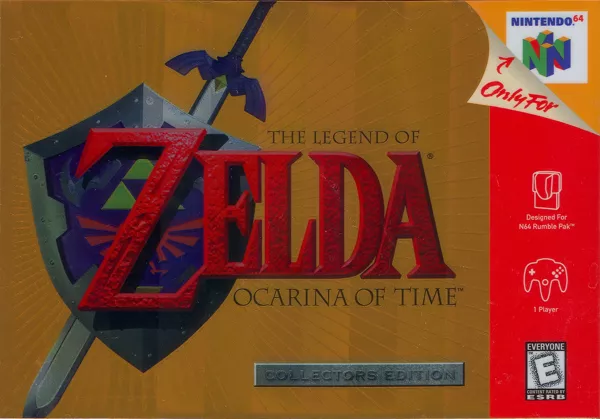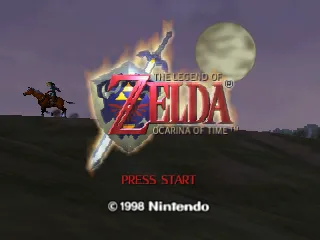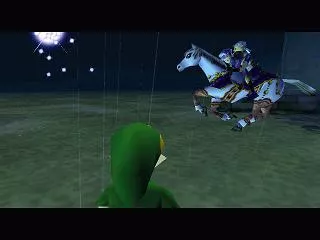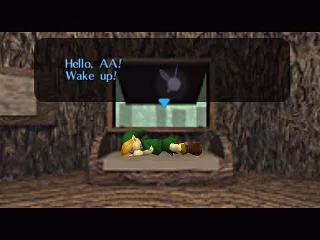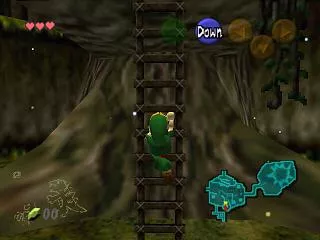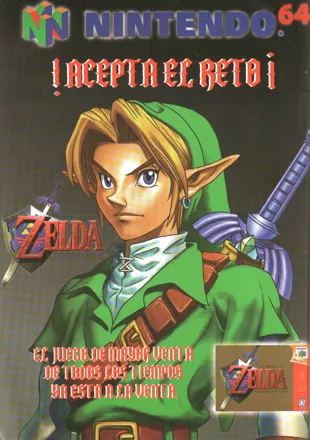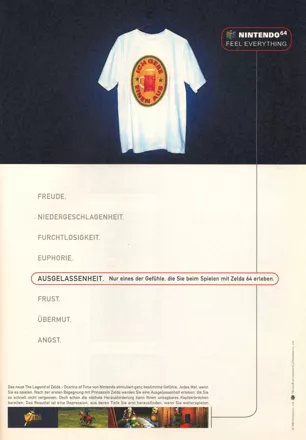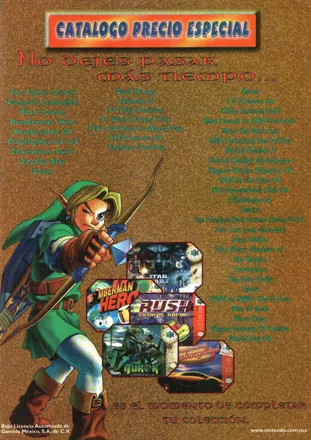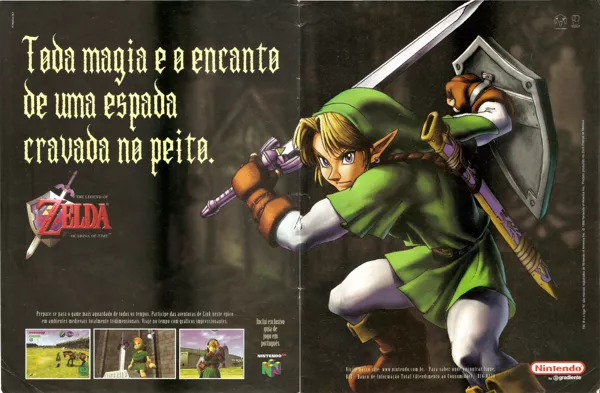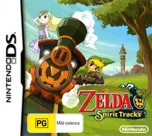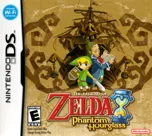The Legend of Zelda: Ocarina of Time
Description official descriptions
A young boy named Link was raised in the village of the elf-like Kokiri people. One day a fairy named Navi introduces him to the village's guardian, the Great Deku Tree. It appears that a mysterious man has cursed the tree, and Link is sent to the Hyrule Castle to find out more. Princess Zelda tells Link that Ganondorf, the leader of the Gerudo tribe, seeks to obtain the Triforce, a holy relic that grants immense power to the one who possesses it. Link must do everything in his power to obtain the Triforce before Ganondorf does, and save Hyrule.
Ocarina of Time is the first 3D installment of the Legend of Zelda series. Like most of its predecessors, it is an action game with puzzle-solving and light role-playing elements. Gameplay is similar to the previous games, allowing Link to explore the world and complete dungeons to obtain key items and advance the plot. Sword combat as well as many familiar items such as boomerang, bombs, the series' currency (rupees) of various values, heart containers, and their collectible fragments permanently increasing Link's health, etc., return in this installment. Link can now lock on enemies for melee and ranged combat, actively use a shield to deflect projectiles, as well as use various magic items. Dungeon exploration is somewhat more puzzle-oriented than in earlier games. Link can climb certain surfaces, dive underwater, as well as automatically jump.
The game begins with the player controlling the child Link, but later on, an adult Link becomes a playable character as well. Each of them has certain unique abilities: for example, only adult Link can use a bow and arrows, but only the child Link can crawl through narrow spaces. During the course of the game, the player obtains the Ocarina of Time. Learning and playing melodies on that ocarina is needed to advance the plot, complete certain side quests, or travel in time, switching between the two versions of Link. It is also possible to befriend and ride a horse named Epona to facilitate travel between areas.
Spellings
- ゼルダの伝説 時のオカリナ - Japanese spelling
Groups +
- Console Generation Exclusives: Nintendo 64
- Game Center CX challenge games
- Gameplay feature: Aging
- Gameplay feature: Auto-mapping
- Gameplay feature: Day / night cycle
- Gameplay feature: Drowning
- Gameplay feature: Equipment quick slots
- Gameplay feature: Fishing
- Gameplay feature: Horse riding
- Games made into books
- Games referenced in movies
- Legend of Zelda series
- Nintendo Player's Choice releases
- Protagonist: Elf
- Setting: Inside a giant creature
- Theme: Time travel
Screenshots
Promos
Videos
See any errors or missing info for this game?
You can submit a correction, contribute trivia, add to a game group, add a related site or alternate title.
Credits (Nintendo 64 version)
76 People (66 developers, 10 thanks) · View all
| Executive Producer | |
| Producer | |
| Director | |
| Program Director | |
| Chief Programmer | |
| Main Program | |
| [ full credits ] | |
Reviews
Critics
Average score: 97% (based on 81 ratings)
Players
Average score: 4.2 out of 5 (based on 429 ratings with 17 reviews)
The game that brought Zelda into the 3D era of gaming!
The Good
This game's wonderful; and even with its already impressive legacy and its age (almost 21 years old as of this review's writing) adds to the game's rather impressive legacy.
The Bad
Sometimes the frame-rate is a little choppy. That doesn't deteriorate the game's splendid graphical fidelity and dungeon-crawling immersion.
The Bottom Line
It's Super Mario 64 meets The Lord of the Rings. It's really that simple and it's that effective.
Nintendo 64 · by John H. (52) · 2019
One of the very best console games.
The Good
The most beautiful, alive, inventive game I've ever seen, and the fictional universe I'd most like to step into. The interface and gameplay are perfect, and every puzzle and monster is creative, but the best thing here is the overwhelming imaginative rendering of the game's 3D universe, the landscapes, towns, and dungeons, each with its own music and atmosphere and personality, in which, to some extent, you can wander around at will and take your time.
The Bad
The game has an ending. It should go on forever. Also, a little too much running.
The Bottom Line
A total masterpiece fantasy adventure game.
Nintendo 64 · by Ran Prieur (17) · 2004
A game for all time and for all player ages!
The Good
A fantastic venture into a world so imaginative, so brilliant, it could only come
from the minds of Nintendo. A rock-solid, intuitive control scheme backed with
the trial-tested gameplay style of the Legend of Zelda series; a vast, vividly
surrealistic world whose threads are bound together by a emotion-stirring
soundtrack and a memorable cast of characters......believe the hype. This game
is perfect.
The Bad
At times, the dialogue seems stilted, and uninspired. Visually, the characters' personalities
are much more remarkable, however.
The Bottom Line
The Ocarina of Time is a game that can be enjoyed by ALL ages. It is not a "children's" game, and if there is even such a thing as one, I'm sure the genre much more closely confined to the realm of Blue's Clues and Rugrats than swashbuckling, time-travelling adventures to save a princess from a sorceror who, according to the lore of the game, seems to be spawned from Satan himself. Pity the person who might be too absorbed in their own "adulthood" to take time off to play an amazing game with an amazing storyline that DOESN'T involve twisted pyschological motives, guerilla warfare/and/or/prostitution. Perhaps that sort of person is too "grown up" to see past the very end of their nose. This game is highly recommened to anyone who isn't so jaded as to not experience beauty in a fairytalish, medieval world as told in The Legend of Zelda: Ocarina of Time.
Nintendo 64 · by Matthew Broussard (6) · 2005
Discussion
| Subject | By | Date |
|---|---|---|
| Am I the only one? | GAMEBOY COLOR! (1990) | Jul 15, 2012 |
| Beta screenshots ? | GAMEBOY COLOR! (1990) | Jun 13, 2009 |
Trivia
1001 Video Games
The N64 version of The Legend of Zelda: Ocarina of Time appears in the book 1001 Video Games You Must Play Before You Die by General Editor Tony Mott.
Development
The Legend of Zelda: Ocarina of Time started life in development for Nintendo's 64DD add-on for the Nintendo 64 (which was a disk drive that was only released in Japan with little fanfare). The 64DD flopped in Japan and it wasn't even released in the USA. As a result, this game, instead of being released in disks, was crammed into a cartridge (which was the biggest N64 pre-Expansion Pak cartridge released, in terms of space). Even though it was originally developed and planned for the 64DD, it was announced to much surprise that Zelda would release in cartridge form for the N64 first; further indicating that the disk drive platform was not gaining the traction Nintendo had hoped for.
Cartridge
Due to overwhelming fan requests, Nintendo decided to release the original production releases of the game as a gold-colored cartridge, restoring the 'golden cartridge' lineage that had previously been broken by the SNES version of The Legend of Zelda: A Link to the Past, and The Legend of Zelda: Link's Awakening for Game Boy.
Versions
There are at least three different versions of the game: 1.0, 1.1 and 1.2. The golden (limited edition) carts, as well as some gray carts, are all 1.0. The majority of the ordinary gray carts are 1.1, and many of the later produced ones are 1.2.
The only notable change between 1.0 and 1.1 is that the Fire Temple music was changed a little bit. It had a chant from an Islamic prayer looped in the background which offended some members of the Islamic community. 1.1 also fixed some bugs, the most famous of them being the sword-losing bug. In 1.0, if the player saves the game in the end battle after losing the Master Sword, and restart the game, they don't have the sword anymore, but they can use all items while riding Epona. Also the final boss originally had red blood which was changed to green in a later version.
Fan remake
Daniel Barras was making a PC fan remake of the game, titled Ocarina of Time 2D. Basically, this was to be a remake with all of the story, areas, creatures and items from The Legend of Zelda: Ocarina of Time, using graphics similar to The Legend of Zelda: A Link to the Past. Regrettably, Nintendo was not very happy about this (or any other Zelda remakes that use The Legend of Zelda: A Link to the Past sprite rips), so the project is gone now.
Stone of Agony
The Stone of Agony allows players to feel a rumble to find hidden areas. This of course only works if they have a rumble pack accessory attached to their N64 controller (or are playing the Gamecube version). For the Wii Virtual Console version, this feature has been disabled.
Left-handedness
Link has always been left-handed, but it is particularly noticeable starting with this game. In the original title, this wasn't always noticeable due to sprite-flipping techniques. The reason for Link's left-handedness is that his creator, Shigeru Miyamoto, is also left-handed.
Voice acting
Voice acting for the adult Link was done by Nobuyuki Hiyama, who also did the voice acting for Link in Super Smash Bros. The person who did the voice of Link as a child, Fujiko Takimoto is a woman. This explains Link's extremely high voice.
Ad controversy
An advertisement for Ocarina of Time shown in British TV proved to be controversial. Using the slogan "Willst thou get the girl? Or play like one?", the ad provoked complaints to the Independent Television Commission from viewers who considered it sexist. ITC however ruled against taking the ad off the air, stating that "such tongue-in-cheek treatments were unlikely to have the widespread negative affect that those who complained feared."
References: Zelda series
- Many of the character names, such as Rauru, Mido, Ruto, Saria, and Darunia, are actually names of towns in
Zelda II: The Adventure of Link . - The characters Malon and Talon are based on Marin and Tarin from The Legend of Zelda: Link's Awakening. Marin was a Zelda lookalike who also had a beautiful singing voice.Tarin was her father and had a liking for mushrooms (he resembled Mario).
References
- Both Talon and his assistant Ingo resemble Mario and Luigi, although it's interesting to note that they have an antagonistic relationship. Both Talon and Malon wear medallions that are shaped like Bowser's head.
- Looking through the windows of Zelda's Castle, players can see pictures of Mario, Bowser and other
Super Mario Bros. characters adorning the walls. - When using a GameShark, the player can make Arwings appear that will attack Link. The Arwing is the primary spacecraft of the
Star Fox series . - The horse in the game is named after the Celtic horse goddess, Epona.
- The lantern-carrying ghosts called Poes are named after the famous horror writer
Edgar Allan Poe . - In the Forest Temple the player encounters the four Poe sisters: Joelle, Beth, Amy, and Meg. They are named after the four protagonists of the novel Little Women by
Louisa May Alcott .
Awards
- EGM
- February 2006 (Issue #200) - #8 out of 200 of the "Greatest Games of Their Time" list
- Game Informer
- August 2001 (Issue #100) - #11 on the "Top 100 Games of All Time" poll
- GameSpy
- 2001 – #43 Top Game of All Time
- Nintendo Power
- Issues #196-200 - #1 "Top 200 Nintendo Console Games of All Time"
- Retro Gamer
- October 2004 (Issue #9) – #5 Best Game Of All Time (Readers' Vote)
- WatchMojo
- August 2014 - ranked #1 in the Top 10 Video Games of All Time
- The Strong National Museum of Play
- 2022 – Introduced into the World Video Game Hall of Fame
Information also contributed by Andrew Shepard, Attila, Big John WV, festershinetop, Guy Chapman, Mark Ennis, Matt Neuteboom, ModestMr.Green, Tiago Jacques, WildKard, and WWWWolf.
Analytics
Upgrade to MobyPro to view research rankings!
Related Sites +
-
OC ReMix Game Profile
Fan remixes of music from The Legend of Zelda: Ocarina of Time. -
The Legend of Zelda: Ocarina of Time/Master Quest
Nintendo of America's official web site for the GameCube version. -
Zelda 64 Fan Site
A fan site dedicated to the Nintendo 64 Legend of Zelda -
Zeldapower.com Forums
Message Boards for all of the Zelda games
Identifiers +
Contribute
Are you familiar with this game? Help document and preserve this entry in video game history! If your contribution is approved, you will earn points and be credited as a contributor.
Contributors to this Entry
Game added by Kartanym.
Wii U added by Michael Cassidy. Nintendo Switch added by Rik Hideto. Wii added by Sciere.
Additional contributors: PCGamer77, Jeanne, Joshua J. Slone, gamewarrior, Havoc Crow, BobaMa, Cantillon, Arejarn, Patrick Bregger, Thomas Thompson, FatherJack, John H., WONDERなパン, SoMuchChaotix.
Game added April 3, 2001. Last modified March 11, 2024.
